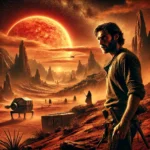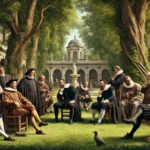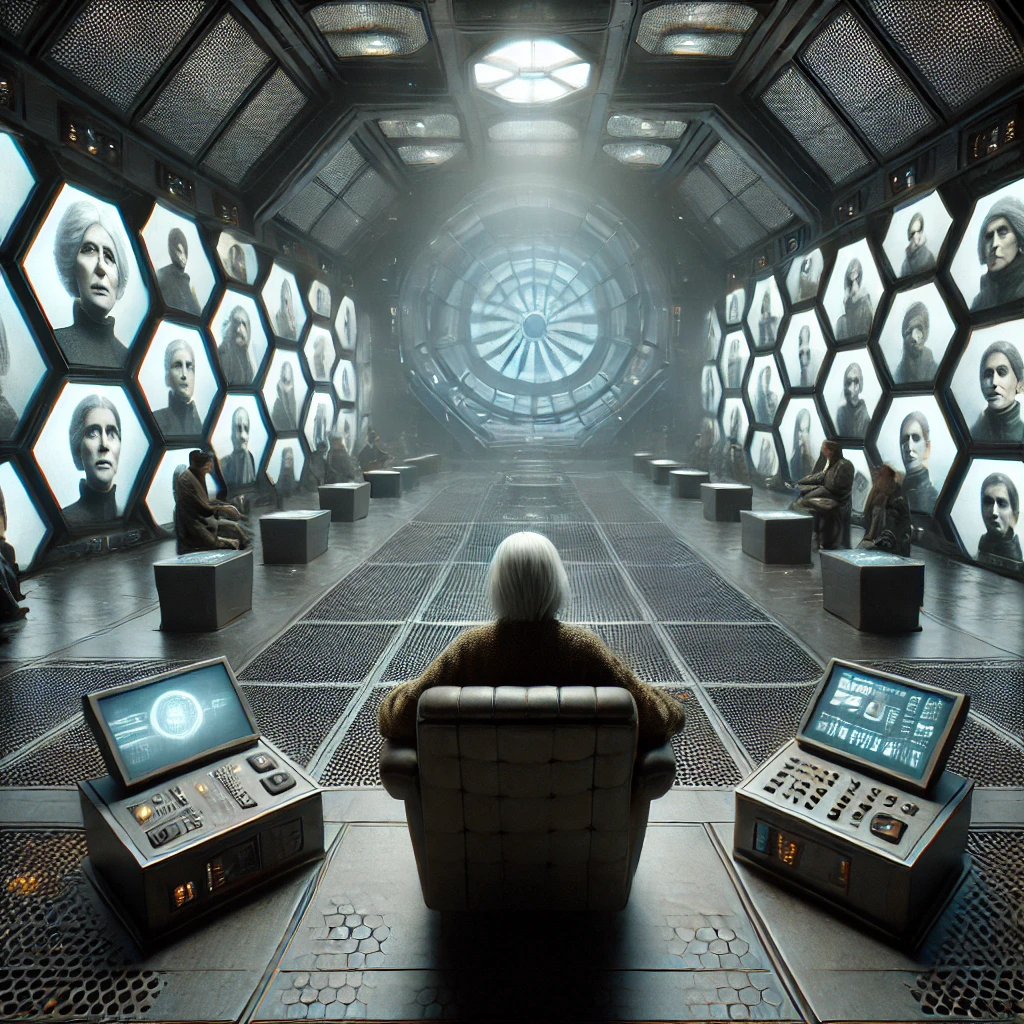Star Maker, published in 1937 by British author William Olaf Stapledon, is a sweeping work of speculative fiction that ventures across the cosmos in search of the origins and ultimate fate of consciousness. Through a first-person narrator’s perspective, Stapledon explores the universe and envisions a multiplicity of alien civilizations, each embodying different forms of intelligence, societal organization, and spiritual development. The novel touches on philosophical inquiries about existence, unity, and the nature of God, making it both a profound cosmic journey and a deep meditation on the limits of human understanding.
Plot Summary
Beneath a quiet, dark sky, a man troubled by life’s limitations contemplates existence, questioning the significance of humanity amidst the vast unknown of the cosmos. Drawn by an intense longing, he is swept from his ordinary surroundings into a journey that transcends the earthly realm. He finds himself liberated from his physical form, able to soar across the stars, and soon ventures into the infinite reaches of the universe. The early stages of his journey offer him views of planets and stars as they drift past, many teeming with life in strange and unfamiliar forms. Yet, in these early explorations, the traveler senses a still deeper mystery, as if the universe holds secrets that lie beyond any one world or species.
Among the celestial bodies, he encounters civilizations that challenge his understanding of life and consciousness. He visits worlds where beings live in perfect harmony, creatures sharing a collective consciousness that blurs the line between individual and community. They communicate without words, their thoughts intertwining in symphonic unity. In these civilizations, individuals exist as expressions of a shared mind, and wars, boundaries, and individual conflict have long been forgotten. The traveler moves through such societies, observing how different forms of intelligence navigate life and community, shaped by their unique environments and evolutions. There is wonder in each discovery, but also the realization of the impermanence of these worlds, for every civilization he encounters eventually reaches its peak and then slowly fades, succumbing to cosmic entropy.
As his journey expands, so does his perception, transforming him into a mind capable of joining and observing entire galaxies as they spin and develop. He witnesses the birth and death of stars, the emergence of planets, and the evolutionary cycles of countless species. Some rise to consciousness, build great civilizations, and then decline. Yet others, held back by isolation or lack of resources, remain simple creatures, their potential locked within distant planets. He moves among these worlds, feeling the ebb and flow of life, growth, and decay as natural pulses of the universe itself. Some worlds are barren, devoid of life, while others teem with strange ecosystems, their forms so alien that the traveler strains to comprehend them. The richness and diversity of life across the cosmos fill him with a deeper understanding, though they also deepen his sense of humanity’s smallness in the grand scheme.
In his encounters with distant stars and ancient galaxies, he senses a greater force that shapes and guides the cosmos, a presence that he comes to know as the Star Maker. Unlike a god born of earthly religion, the Star Maker exists as a creative force, detached from the lives and concerns of its creations. It is an entity of pure purpose, driven by a will to experiment, to bring forth life and structure in infinite forms. Galaxies, it becomes clear, are no more than cosmic attempts at form and meaning, and the civilizations that rise within them are fleeting expressions of a boundless curiosity that cares little for their individual destinies. The Star Maker observes and remakes worlds, watching dispassionately as they evolve and pass away, consumed by their own natural ends.
As his journey stretches across aeons, the traveler witnesses not only the rise and fall of civilizations but the formation of star clusters and galaxies themselves. He observes stars being born and dying, each event shaping the universe’s great tapestry. Within each galaxy, life emerges, evolving along countless paths—some beings developing advanced intellect, others reaching only rudimentary forms of awareness. On one distant world, he encounters a society of beings who, unlike humans, possess a blend of biological and mental powers that allow them to traverse their planet in peace, communing with one another in mutual understanding. On another world, he observes a civilization marked by hostility and domination, the beings driven by primal urges to conquer and control. The traveler observes their wars and conflicts with a growing sense of sorrow and wonder at the many shapes life can take.
In time, his perception expands even further, allowing him to view multiple galaxies and the forces governing their formation and dissolution. He comes to see how even galaxies are impermanent, with each one destined to eventually scatter and dissolve, leaving only traces in the fabric of space. The entire universe, he realizes, is in flux—a cosmic dance with no permanence. He senses how the Star Maker’s work is never-ending, driven by a relentless desire to experiment with different cosmic arrangements and forms of life, each galaxy another attempt, a variation in an endless series. The Star Maker itself remains distant, untouched by the rise and fall of its creations, creating and discarding worlds with an indifferent hand.
Finally, the traveler reaches a place where he can see beyond the universe’s visible boundaries, into realms where even the stars and galaxies are but ephemeral sparks. He perceives that the universe is but one among many, a single expression within an endless array of potential realities, each shaped by different laws and principles. Here, his own sense of individuality begins to dissolve, merging with the cosmic whole, and he realizes that he, too, is but a fleeting part of the Star Maker’s grand design.
As the journey nears its end, he contemplates the purpose of all he has witnessed. In the vast web of interconnected beings, stars, and galaxies, he understands that life, no matter how brief, holds intrinsic beauty. Even the smallest consciousness, the briefest spark of life, contributes to the universe’s richness, a testament to the Star Maker’s ceaseless creativity. And though the Star Maker remains forever unreachable, the traveler feels a sense of peace in his understanding. He realizes that humanity’s yearning for connection and meaning is mirrored across the cosmos, a part of the endless striving that binds all life.
In the final moments, he finds himself back on Earth, standing once again under the familiar stars. Though the enormity of his journey defies memory, fragments of the cosmic vision remain. His perspective has shifted; he sees humanity now as a small but integral part of the vast universe, one brief flame in the boundless sea of stars, yet no less valuable for its brevity. In this understanding, he finds solace, embracing the beauty of existence, however fleeting, within the infinite cycles of creation.
Main Characters
- The Narrator: An unnamed, introspective individual, the narrator embarks on an extraordinary cosmic journey beyond Earth, initially motivated by discontent with the trivialities of human life. Through his vast journey, he transitions from a localized human perspective to a universal consciousness, expanding his understanding of existence and cosmic unity.
- Star Maker: The Star Maker is a god-like creator entity introduced later in the novel. This being is presented not as a deity in the traditional sense but as an unknowable force responsible for all creation. As the narrator attempts to comprehend this cosmic force, he finds it elusive and indifferent, embodying a form of creative power and purpose beyond human moralities or emotions.
- Alien Civilizations: Throughout the journey, the narrator encounters various alien species representing a vast spectrum of life forms, societal structures, and stages of consciousness. These civilizations become key characters in themselves, as their distinct modes of existence highlight the diversity and potentiality within the cosmos.
Theme
- Unity and Cosmic Evolution: A major theme is the idea of unity across diverse life forms, which evolve and connect in a way that transcends individuality, promoting a collective consciousness. The cosmic evolution theme depicts the universe as a process striving toward higher levels of organization and comprehension.
- The Nature of God and Creation: Stapledon explores the nature of creation itself, presenting the Star Maker as a distant, indifferent force, detached from individual suffering but pivotal in shaping the universe. This exploration challenges anthropocentric views of God, suggesting a creator whose purpose may not align with human-centered ideals.
- Isolation and the Search for Meaning: The narrator’s journey is also one of isolation, as he distances himself from the familiar to confront the vastness of existence. This theme reflects humanity’s quest for meaning in an indifferent cosmos, a search that often leads to existential revelations rather than comforting answers.
- Impermanence and Mortality: Through civilizations that rise, thrive, and eventually fall, Stapledon addresses the transience of all life forms, whether individual, societal, or cosmic. This impermanence urges a perspective that values interconnectedness over permanence, presenting mortality as a shared trait across existence.
Writing Style and Tone
Stapledon’s writing in Star Maker is grand, contemplative, and philosophical, designed to evoke both wonder and reflection. His descriptions often convey a stark, impersonal beauty, aligning with the cosmic scale of the narrative. The language he employs is meticulously chosen to portray the awe-inspiring, often alien landscapes and life forms the narrator encounters, balancing intricate detail with a detached, scientific curiosity. This tone gives readers a sense of the profound otherness and grandeur of the universe, setting a distinctly philosophical mood that challenges conventional human perspectives.
The tone shifts between reverence and existential dispassion as the narrator delves deeper into cosmic mysteries. Stapledon’s prose oscillates between introspective and descriptive passages, with some sections reading like spiritual meditations, while others adopt the clarity and cool precision of scientific observation. This dual approach mirrors the narrator’s own progression from an earthly, human perspective to a broader, nearly divine consciousness, drawing readers into a meditation on the nature of existence, intelligence, and the unknown.
We hope this summary has sparked your interest and would appreciate you following Celsius 233 on social media:
There’s a treasure trove of other fascinating book summaries waiting for you. Check out our collection of stories that inspire, thrill, and provoke thought, just like this one by checking out the Book Shelf or the Library
Remember, while our summaries capture the essence, they can never replace the full experience of reading the book. If this summary intrigued you, consider diving into the complete story – buy the book and immerse yourself in the author’s original work.
If you want to request a book summary, click here.
When Saurabh is not working/watching football/reading books/traveling, you can reach him via Twitter/X, LinkedIn, or Threads
Restart reading!








